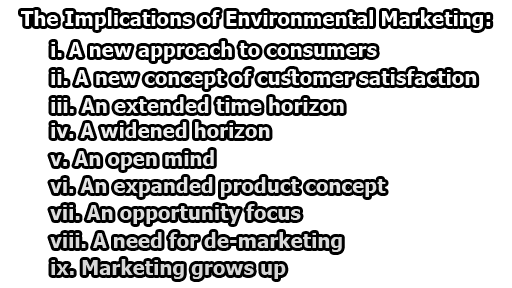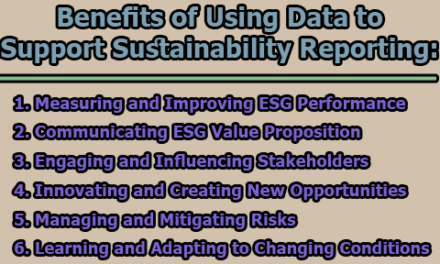The Implications of Environmental Marketing
Environmental Marketing is used in the sense of relating Marketing to the inseparable social and physical (green) environments in which consumers and businesses exist. Environmental marketing (or green marketing) is the marketing of products and services that are environmentally safe. In the rest of this article, we are going to know about the implications of Environmental Marketing.
The implementation of environmental marketing is a great challenge for the marketer. The challenges of greening the philosophy and practice of marketing will require a re-evaluation of some of its most fundamental elements. Some of these elements where Environmental Marketing is implicated are mentioned here:
i. A new approach to consumers: Environmental Marketers need to view consumers as customers, as citizens of the society, and also as physical human beings. Marketing theory tends to focus on one customer need at a time. People have a variety of wants, some of which may conflict. Consumers might want personal mobility and also want a safe and clean urban environment in which to raise their children.
ii. A new concept of customer satisfaction: In the past consumer satisfaction has been judged in terms of the performance of the product at the moment of consumption. Environmentally concerned consumers can reject a product because they are made aware of the social and environmental harm that it causes in production or disposal.
iii. An extended time horizon: Environmental marketing requires a long time perspective than gray marketing. The marketer’s time horizon must now go beyond the economic life to consider the environmental impact of its disposal and the long-term effect of product use.
iv. A widened horizon: Geographically the green challenge forces companies to think internationally and globally to understand the socio-environmental impact of their product, production process, and sourcing policies. Economically it also forces them to think across industry boundaries. It cannot be understood from a nationalistic or a single industry standpoint.
v. An open mind: The green challenges may also require marketers to abandon many of their preconceptions about their customers, their products, and the nature of their market. The green challenge is emphasizing the socio-environmental costs of products when marketers are used to focusing on the techno-economic benefits and their role in solving, rather than causing, problems for customers.
vi. An expanded product concept: If green consumer satisfaction depends upon the production process and on all activities of the producer, we are approaching the situation where the company itself is becoming the product consumed.
vii. An opportunity focus: In the past, the environment has been viewed in terms of legal responsibilities and cost burdens by businesses. However Environmental Marketing should be a positive approach, it is as much about new opportunities as about new threats and restrictions.
viii. A need for de-marketing: One unavoidable conclusion is that where a product is being consumed and produced in an unsustainable way, it may have to be de-marketed (either voluntarily or forcibly) to reduce consumption.
ix. Marketing grows up: Environmental Marketing should not be confused with attempts to exploit consumers’ environmental concerns to promote companies or sell products. Instead of talking about consumer needs whether clothes are whiter than white, environmental marketing means tackling issues that affect the fundamentals of people’s quality of life, and which may even prove life-threatening.

Library Lecturer at Nurul Amin Degree College










